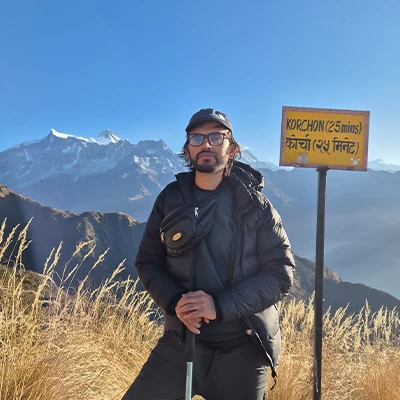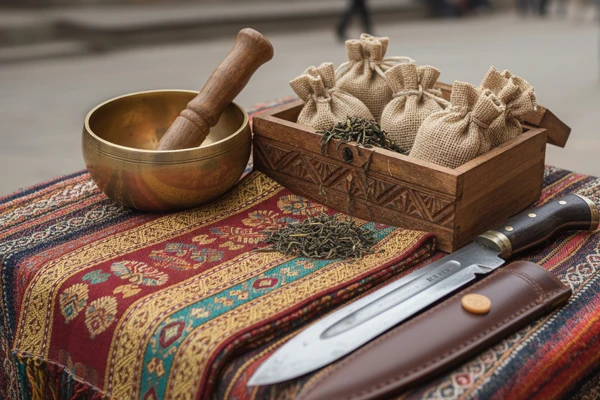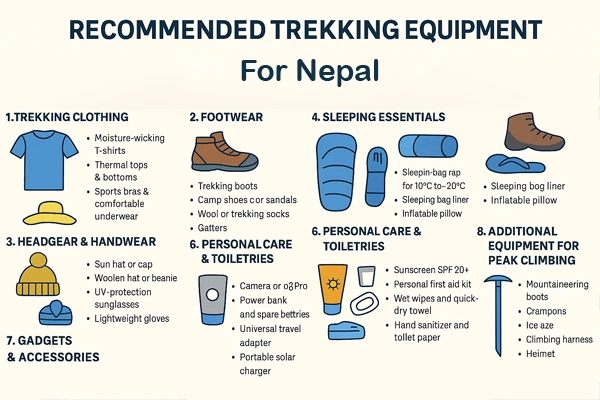Why Choosing the Right Trekking Shoes in Nepal is Crucial
Trekking in Nepal is a dream adventure, but the wrong footwear can turn it into a painful ordeal. The rugged terrain, unpredictable weather, and long hours of walking demand footwear that offers support, durability, and comfort. Here’s why selecting the right trekking shoes in Nepal is essential:
Nepal’s trails range from smooth stone paths to rocky ascents, muddy slopes, and even snow-covered passes. Poor shoes can lead to slips, ankle twists, or long-term foot fatigue.
Temperatures swing from daytime heat to freezing nights. Thin-soled or non-waterproof shoes can cause frostbite, blisters, or hypothermia in extreme cases.
Most treks involve 5–8 hours of walking daily, often with a backpack. Proper trekking shoes distribute weight evenly and reduce joint stress.
Ill-fitting or non-breathable shoes cause blisters, hot spots, and fungal infections
Overview of Nepal’s Terrain and Weather Conditions
Nepal’s dramatic landscapes present some of the world’s most spectacular trekking routes. But this beauty comes with challenging terrain and unpredictable weather that demand proper footwear. The trails transition sharply from tropical lowlands to arctic high-altitude zones, each presenting unique demands on your shoes. In the steamy jungles of the Terai and lower foothills, you will need breathable shoes that dry quickly after crossing monsoon-soaked trails or river crossings. As you ascend through the middle hills (1,000-3,500m), the terrain becomes a mix of ancient stone staircases, exposed roots, and occasional landslide areas where ankle support and aggressive treads become essential. The real test comes above 3,500 m, where trails turn to rocky moraines, icy slopes, and snow-covered passes.
Weather adds another layer of complexity across seasons. Spring trekkers enjoy warm days but face dusty trails that degrade soft soles. Monsoon hikers battle slippery mud and relentless leeches that demand waterproof protection. Autumn’s perfect conditions still require versatile shoes for chilly mornings and hot afternoons. Winter brings sub-zero temperatures, where thermal insulation becomes a safety requirement rather than a comfort feature. Some of Nepal’s most famous crossings, like icy Thorong La Pass or the landslide-prone trails near Manaslu, have turned back unprepared trekkers solely due to inadequate footwear.
The right trekking shoes for Nepal are not just about comfort; they are about adapting to conditions that can swing from scorching heat to cold within the same trek. A single journey from Pokhara to Annapurna Base Camp might take you through humid rainforests, across cold mountain streams, and finally onto glacial moraines. Each environment will test your footwear in different ways. While stunning vistas reward your efforts, the wrong shoes can transform this adventure into a painful ordeal of blisters, sprains, or worse. That is why understanding Nepal’s diverse terrain and weather patterns forms the crucial first step in choosing footwear that will keep you safe and comfortable from the trailhead to the summit.
Key Features to Look for in Trekking Shoes
Choosing the right trekking shoes is one of the most important decisions you will make before hitting Nepal’s trails. The wrong pair can lead to blisters, fatigue, or even injuries, while the right one will keep you comfortable and stable across rough terrain. Here is a detailed breakdown of the five most critical features to consider when selecting trekking shoes in Nepal:
Durability & Material
Nepal’s trails are merciless on footwear. One week of trekking here can wear out shoes that would last months elsewhere. That’s why construction matters. Genuine leather uppers (full-grain or nubuck) offer the best protection against sharp rocks and abrasive trails, though they require breaking in. Synthetic materials (like reinforced mesh) keep shoes lightweight but sacrifice long-term durability.
Look for double-stitched seams and Vibram soles; cheap glued soles often fail when you need them most. Reinforced toe caps and heel counters add crucial protection when scrambling over boulder fields or kicking steps into snowy slopes. Remember: On remote Himalayan trails, shoe failure is not just inconvenient, it can be dangerous.
Ankle Support & Stability
You are descending 1,000m on loose scree, and your pack is throwing off your balance. This is where ankle support becomes critical. High-cut boots (covering the ankle bone) provide the best protection for heavy loads and uneven terrain, while mid-cut shoes offer a balance for moderate trails. Low-cut trail runners? Save them for day hikes.
Look for stiff shanks that prevent foot fatigue on long rocky sections. A secure heel lock stops slippage that causes blisters. In Nepal’s mountains, where a single misstep can mean a helicopter evacuation, proper support isn’t luxury, it’s survival gear.
Waterproofing & Breathability
Morning frost, afternoon monsoon rains, and river crossings test footwear’s water resistance daily. Gore-Tex membranes handle snow and rain best, but can feel like saunas in humid lowlands. Non-waterproof shoes work for dry seasons but leave you vulnerable to sudden storms. While keeping water out, shoes must also let sweat escape. Look for vented uppers and moisture-wicking liners to prevent the dreaded "trekker’s foot"—a soggy, blister-prone mess. In the Annapurna region’s rice terraces or Everest’s glacial valleys, mastering this balance separates comfortable trekkers from suffering ones.
Traction & Grip
Nepal’s trails transform with elevation: muddy foothills, polished stone stairs, icy moraines. Your soles must adapt. Vibram’s megagrip compound sets the gold standard, especially on wet rocks. Deep, multi-directional lugs claw through monsoon mud, while softer rubber sticks to smooth granite. Watch out for shallow treads because they are useless when crossing the Marsyangdi River’s slippery boulders. On high passes like Cho La, grip becomes a safety issue where one slip could be catastrophic.
Comfort & Fit
The perfect trekking shoe fits like a second skin with the room at the toes, snug at the heel, with no pressure points. Feet swell at altitude, requiring a half-size up. Thick trekking socks demand extra width. A wide toe box prevents numbness during long descents. Break shoes in properly: Walk 50km on mixed terrain before your trek. Because when you are five days from the nearest road, there is no breaking them in along the way.
Types of Trekking Shoes for Nepal
Nepal's diverse trails demand different types of footwear, from breathable trail runners for gentle hikes to burly mountaineering boots for high-altitude expeditions.
Lightweight Trail Shoes
Perfect for beginners or those sticking to Nepal's gentler trails, lightweight trail shoes prioritize speed and comfort over heavy-duty protection. These low-cut or mid-cut shoes feature flexible soles and breathable mesh uppers, making them ideal for warm-weather hiking with light loads. You will appreciate their quick-drying properties when crossing streams in the Annapurna foothills or navigating the occasional monsoon shower. However, their minimal ankle support makes them risky for rough terrain. A twisted ankle is far more likely when scrambling over the rocky sections near Australian Camp or the steeper parts of the Kathmandu Valley hikes.
Popular choices like the Merrell Moab Ventilator work well for short treks like Ghorepani Poon Hill (3-5 days), where well-maintained stone paths and frequent tea houses reduce the need for heavy footwear. Just remember: while these shoes excel on Nepal's easier routes, they'll leave you dangerously underprepared for anything beyond moderate day hikes.
Duration: 3 Days
Price from
Duration: 3 Days
Price from
2. Mid-Weight Hiking Boots
When tackling Nepal's iconic moderate-difficulty routes, mid-weight hiking boots strike the perfect balance between support and agility. Their higher ankle collars and stiffer soles provide crucial stability on the Annapurna Base Camp trek's endless stone staircases, while waterproof membranes keep your feet dry during unexpected snow flurries near Machhapuchhre Base Camp. The Salomon Quest 4 GTX exemplifies this category, offering enough rigidity for Langtang Valley's rocky trails yet remaining comfortable enough for 10+ day treks. These boots truly shine on routes like the Everest Panorama trek (5-7 days), where you will encounter everything from humid rhododendron forests to chilly mornings in Tengboche.
While heavier than trail runners, their versatility makes them Nepal's most popular choice, capable of handling everything except the most extreme high-altitude conditions. Just be sure to break them in properly before your trek to avoid blisters on those long descents from Deurali or Chhomrong.
3. Heavy-Duty Trekking Boots
For serious adventurers tackling Nepal's high passes and remote routes, nothing less than heavy-duty trekking boots will suffice. These fortress-like boots feature rigid soles compatible with crampons – essential when crossing the icy slopes of Cho La Pass on the Everest Three Passes trek or navigating Thorong La's (5,416m) unpredictable conditions. The Trango Trek Gtx, with its full-grain leather construction and Gore-Tex lining, provides the uncompromising support needed for multi-week expeditions like the Manaslu Circuit, where help is days away if something goes wrong. While overkill for easier trails, these boots become indispensable when carrying heavy packs through the Dhaulagiri Circuit's boulder fields or winter treks where temperatures plunge below -20°C. Expect a lengthy break-in period of at least 50km of wear. But once properly conditioned, they will carry you safely through Nepal's most extreme environments.
Duration: 13 Days1 Review
Price from
Where to Buy Trekking Shoes in Nepal?
Kathmandu and Pokhara offer several reliable stores with a wide selection of authentic trekking shoes. Kalapatthar Trekking Store in Thamel is a trusted shop known for its range of high-quality boots at competitive prices. Nearby, Ocean Trekking Gear stands out for its knowledgeable staff who can help you find the perfect fit for your specific trek.
If you are searching for premium international brands, the Outdoor Compass Shop in Kathmandu carries top-tier options with a reputation for selling genuine products rather than counterfeit gear. Meanwhile, Goreto Gear Traders is another excellent choice, particularly for budget-conscious trekkers, offering a mix of affordable and mid-range boots that still deliver good performance on Nepal’s trails.
For those starting their trek from Pokhara, shops around Lakeside also stock reliable footwear, though the selection may be slightly smaller than in Kathmandu. Wherever you buy, always inspect the shoes carefully, try them on with trekking socks, and walk around the store to ensure proper fit before hitting the trail. Renting is also an option for short treks, but for serious hikes, investing in a well-fitted pair from a reputable store is the best way to ensure comfort and safety.
Renting vs. Buying – Pros & Cons
When preparing for a trek in Nepal, one key decision is whether to rent or buy your footwear. Each option has advantages and drawbacks, depending on your trekking style, budget, and future hiking plans.
Renting Trekking Shoes in Nepal
Pros:
Cost-Effective for Short Treks: Ideal if you are only doing a one-week hike like Poon Hill or Langtang, saving you from a big upfront investment.
No Break-In Required: Rental shops often provide pre-used (but functional) boots that are already broken in, reducing blister risks.
Avoid Carrying Extra Luggage: Useful if you’re traveling light and don’t want to haul bulky boots before/after your trek.
Cons:
Limited Quality & Fit Options: Rental boots may be worn out, lack proper support, or not fit perfectly, increasing discomfort on long trails.
Hygiene Concerns: Even cleaned rentals may retain odors or bacteria from previous users.
Not Ideal for Technical Treks: High-altitude routes (EBC, Manaslu) demand reliable, well-fitted boots—rentals may not meet the standard.
Buying Trekking Shoes in Nepal
Pros:
Perfect Fit & Comfort: You can choose shoes tailored to your foot shape, reducing blisters and fatigue.
Higher Quality & Durability: Invest in boots that last multiple treks, like Scarpa or Lowa, which handle rough terrain better than rentals.
More Options: Access to premium waterproof, lightweight, or high-altitude models that rentals rarely stock.
Cons:
Expensive Initial Cost: Good boots cost $150–$300, a steep price if you’re a casual trekker.
Break-In Period Required: New shoes need 30–50km of walking to mold to your feet, which may not be practical pre-trek.
Bulky to Travel With: If you’re not trekking frequently, carrying heavy boots can be inconvenient.
How to Avoid Blisters & Discomfort
Blisters can ruin even the most spectacular Himalayan adventure, but with the right preparation, you can keep your feet happy across Nepal’s punishing trails. Here’s a battle-tested strategy:
Feet swell at altitude—leave a thumb’s width of space beyond your longest toe.
Try shoes while wearing the same socks you’ll hike in (merino wool recommended).
Wear new shoes for 2+ weeks before your trek—walk hills, stairs, and uneven ground.
Stop immediately if you feel friction; apply tape or moleskin before a blister forms.
Using poles reduces foot impact by ~25%, preventing toe-jamming on descents—a major blister cause.
Frequently Asked Questions (FAQs)
Can I use running shoes for trekking in Nepal?
While running shoes may be comfortable for short walks or city exploration, they are generally not suitable for serious trekking in Nepal's rugged terrain. The Himalayan trails present challenging conditions, uneven rocky paths, steep ascents and descents, river crossings, and unpredictable weather. So, it demands proper footwear with ankle support, durable soles, and often waterproofing.
Running shoes lack the necessary grip, stability, and protection for long-distance trekking, increasing your risk of slips, twisted ankles, and foot fatigue. They might suffice for very short and easy hikes like Ghorepani Poon Hill, but for anything more demanding, sturdy trekking shoes or boots are essential to ensure safety and comfort.
Are Gore-Tex shoes necessary?
Gore-Tex (or similar waterproof/breathable membranes) can be extremely useful in Nepal, but whether they are necessary depends on the season and trekking route. During the monsoon (June–September), trails become muddy and slippery, making waterproof shoes invaluable. Similarly, in winter (December–February) or at high altitudes where snow and freezing temperatures are common, Gore-Tex helps keep feet dry and warm. However, in dry seasons (October–November and March–May), non-waterproof, breathable shoes may be more comfortable, as Gore-Tex can trap sweat in warmer conditions. If you're on a budget, waterproof socks (like Sealskinz) can be a good alternative. Ultimately, the decision should be based on your trek's conditions. Waterproof shoes are highly recommended for wet, cold, or high-altitude adventures.
How much should I spend on good trekking shoes?
The price of trekking shoes in Nepal varies widely, but investing in a quality pair is crucial for comfort and safety. Budget options ($50–$100), such as the Quechua MH500 or Merrell Moab Ventilator, can work for short and easy treks but may lack durability for long or challenging hikes.
Mid-range shoes ($120–$200), like the Salomon Quest 4 GTX or Lowa Renegade, offer better support, waterproofing, and longevity, making them ideal for most treks in Nepal. For high-altitude or technical routes (e.g., Everest Three Passes, winter treks), premium boots like the Salomon X Ultra 4 Mid provide superior protection and crampon compatibility. A good rule of thumb is to buy the best you can afford.
Do I need insulated boots for Nepal?
Insulated boots are only necessary in specific conditions. If you are trekking in winter (December–February), especially at high altitudes (e.g., Everest Base Camp, Annapurna Circuit), temperatures can drop well below freezing, and insulated boots help prevent frostbite. Similarly, if you are crossing snow-covered passes (like Thorong La or Cho La), insulation adds crucial warmth. However, for spring, autumn, or lower-altitude treks, insulated boots are usually overkill—standard waterproof boots paired with thick wool socks provide enough warmth without causing overheating. Always check weather forecasts before your trek and pack accordingly.
How do I waterproof my shoes before the trek?
Even waterproof shoes (e.g., Gore-Tex models) lose their effectiveness over time, so reapplying a waterproofing treatment is essential. For leather boots, use a wax-based conditioner (like Nikwax or Sno-Seal) to nourish the leather and enhance water resistance. For synthetic shoes, a DWR (Durable Water Repellent) spray (such as Nikwax TX Direct) helps restore the outer fabric's water-shedding ability. Apply the product before your trek and reapply every few hikes, especially after heavy use or exposure to wet conditions. Avoid drying wet shoes near direct heat (fires, heaters), as this can damage materials. Instead, stuff them with newspaper to absorb moisture overnight. Proper maintenance extends the life of your shoes and keeps your feet dry on the trail.









